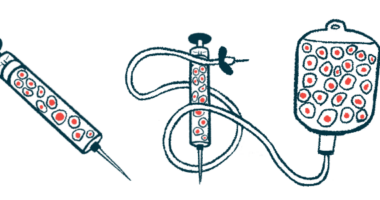Modified stem cell therapy aids familial Parkinson’s motor function
Cells are engineered to have reduced activity of faulty SNCA gene

Transplanting stem cells genetically engineered to have reduced activity of a faulty SNCA gene improved motor function and extended lifespan in a mouse model of SNCA-associated Parkinson’s disease, a study shows.
“The results of this study suggest an innovative therapeutic approach that combines stem cell therapy and gene therapy for the treatment of Parkinson’s disease,” the researchers wrote.
The study, “Neural stem cells derived from α-synuclein-knockdown iPS cells alleviate Parkinson’s disease,” was published in Cell Death Discovery.
In Parkinson’s disease, dopaminergic neurons, which are the nerve cells responsible for producing the brain signaling chemical dopamine, progressively degenerate, leading to motor issues and a host of nonmotor symptoms.
Neural stem cells (NSCs), the precursors to neurons and other cell types that live in the brain, have shown promise for treating Parkinson’s disease. The idea is that these self-renewing cells can repopulate the brain with healthy dopaminergic neurons to replace those lost to the neurodegenerative condition.
One way to obtain sufficient amounts of the cells for therapeutic use is through a strategy called induced pluripotent stem cells (iPSCs) wherein regular cells, such as skin cells, are collected from a patient and reprogrammed into NSCs, which can then be transplanted back into the patient’s brain. However, the caveat to using this approach in familial forms of Parkinson’s, where an inherited genetic mutation causes the disease or increase the risk of it, is that any stem cells derived from people with it will also contain the disease-causing mutation and the nerve cells they produce could be dysfunctional.
A modified approach to stem cell therapy
Here, the scientists explored a modified approach to iPSC therapy by genetically modifying the cells to have reduced activity of the mutated gene — called a knockdown — before growing them into NSCs and transplanting them.
The researchers tested the approach in a mouse model of Parkinson’s harboring a mutation in SNCA, a known cause of familial Parkinson’s. Some mice received NSCs engineered to have reduced mutant SNCA activity, while others received NSCs that hadn’t been engineered.
As expected, mice not treated with any stem cell therapy developed significant motor impairments, including problems with balance, coordination, and motor skills.
NSC therapy largely prevented these motor problems from developing, regardless of genetic engineering, but the mice given the engineered stem cells lived significantly longer than the untreated mice and those given the nonmodified stem cells.
Because the nonmodified cells still contained mutated SNCA, they “may improve [Parkinson’s] symptoms, but cannot affect the progression of the disease,” wrote the researchers, who noted, on the other hand, that the cells modified to reduce the harmful effects of mutant SNCA may be able to slow disease progression and therefore extend survival.
Both versions of the stem cell therapy were associated with increases in dopaminergic neurons and reduced cell death.
“Collectively, our study has shown that the knockdown of mutant SNCA in [iPSCs] can provide a suitable source of NSCs for the treatment of Parkinson’s disease caused by mutations in SNCA,” wrote the researchers, who said, because SNCA isn’t the only gene that can be altered in Parkinson’s, future research should explore whether knockdown of multiple genes in iPSCs may enhance the efficacy of NSC therapy.







